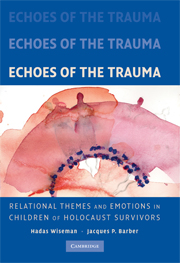Book contents
- Frontmatter
- Contents
- Foreword by Dan Bar-On
- Preface
- Acknowledgments
- 1 Introduction – A Narrative Approach to Bridging the Gap between Clinical Case Studies and Empirical Research on Children of Holocaust Survivors
- 2 Studying Relationship Narratives with the Core Conflictual Relationship Theme Method
- PART ONE RELATIONAL THEMES IN THE NARRATIVES
- 3 Wishes for Closeness and Autonomy
- 4 The Need to Protect Vulnerable Parents and to Avoid Conflicts
- 5 “Without Words”: Themes of Interpersonal Communication
- PART TWO EMOTIONS IN THE NARRATIVES
- PART THREE HEALING TRAUMA IN THE CHAIN OF THE GENERATIONS
- Appendix
- References
- Index
5 - “Without Words”: Themes of Interpersonal Communication
Published online by Cambridge University Press: 29 July 2009
- Frontmatter
- Contents
- Foreword by Dan Bar-On
- Preface
- Acknowledgments
- 1 Introduction – A Narrative Approach to Bridging the Gap between Clinical Case Studies and Empirical Research on Children of Holocaust Survivors
- 2 Studying Relationship Narratives with the Core Conflictual Relationship Theme Method
- PART ONE RELATIONAL THEMES IN THE NARRATIVES
- 3 Wishes for Closeness and Autonomy
- 4 The Need to Protect Vulnerable Parents and to Avoid Conflicts
- 5 “Without Words”: Themes of Interpersonal Communication
- PART TWO EMOTIONS IN THE NARRATIVES
- PART THREE HEALING TRAUMA IN THE CHAIN OF THE GENERATIONS
- Appendix
- References
- Index
Summary
What was the experience like for the child who sensed in the air that there had been a horrifying experience that he or she had not been told about and that was not discussed between the adults and the children? Our participants grew up with parents who were faced with the almost unbearable possibility of telling their children about what they underwent during the Holocaust. Furthermore, they were raised in the 1950s, a time in Israel when survivors were not encouraged to discuss their experiences and the Holocaust was enveloped in silence by Israeli society at large (Bar-On, 1995; Segev, 1993; Shapira, 1997). Such silence was also described regarding the experience of survivors and their children in North America and in other countries, perhaps even more (Danieli, 1983, 1998; Krell, 1979; Rosenthal, 1998).
David Grossman in his novel See under Love (1986; translated 1989) appears to capture the experience of the child who has the need to know and wants to ask the adults what he feels they dare not tell. Grossman indicates to the reader that the story takes place in 1959. This was before the Eichmann trial was held in Israel (it began in April 1961), a landmark event in the process of breaking the silence (Segev, 1993).
- Type
- Chapter
- Information
- Echoes of the TraumaRelational Themes and Emotions in Children of Holocaust Survivors, pp. 79 - 94Publisher: Cambridge University PressPrint publication year: 2008



